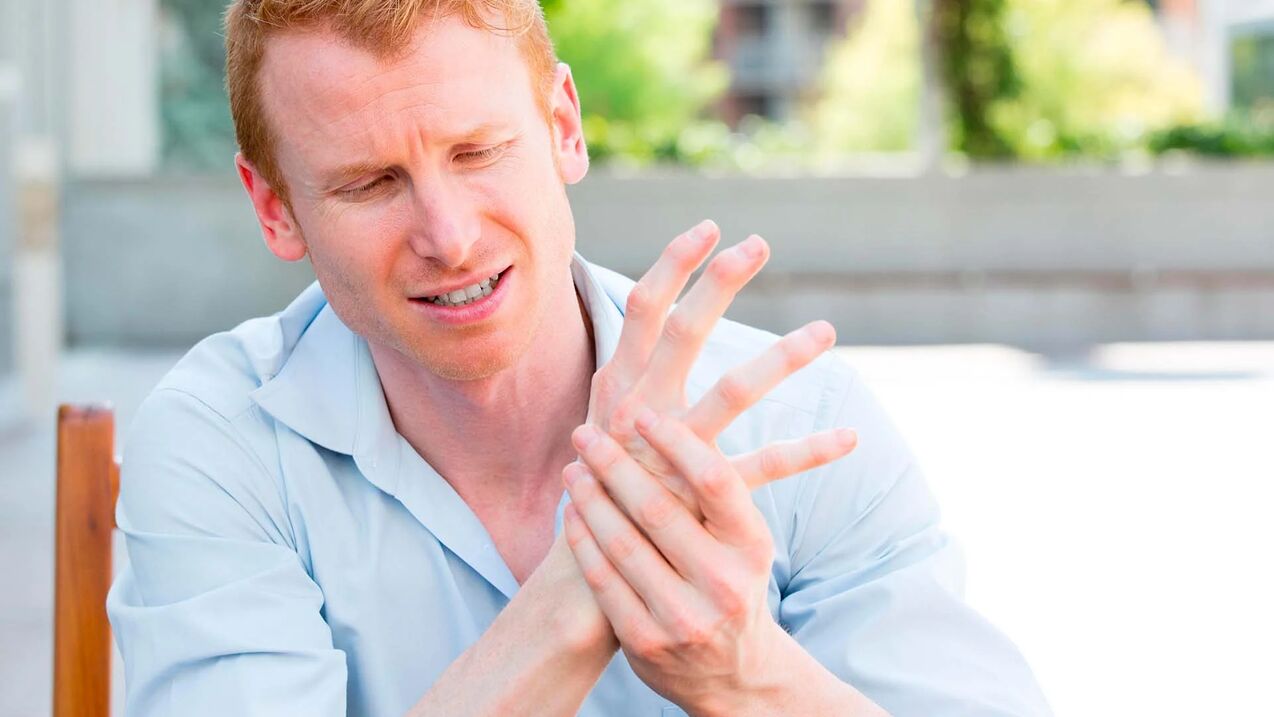
Pain in the joints of the hands can be caused by muscle fatigue or it can be a sign of a dangerous systemic disease. Fortunately, the latter are less common. Often, doctors are faced with injuries and problems of the ligamentous apparatus that respond well to local treatment. When the joints of the hands hurt, the causes and treatment are quite diverse. To treat the pathology of the hands, it is important for the patient to seek help in time, especially if the fingers are deformed: the longer they are in a forced position, the more difficult it is to restore their function. In the article, we will talk about possible diagnoses of pain in the joints of the hands, what to do, how to treat such conditions.
Pain in the small joints of the fingers: causes
Patients who experience numbness, clicking, or pain in the finger joints when bending, stretching, or resting may have a variety of diagnoses.
"Toe impingement" is also known as stenotic ligamentitis or Knott's disease
It is one of the most common causes of hand pain. This is a good pathology in which it is very difficult to fix the finger independently from the bent position. The disease is common among both women and men and is associated with damage to the annular ligament of the hand. There is a feeling that the finger is "stuck" in one position. Usually, the joint of the middle finger of the right hand hurts, as well as the ring or thumb. In left-handed people, the left hand is more affected.
Risk factors include:
- Excessive fatigue of the wrist flexor muscles. This can happen when working at the computer for long periods of time, driving long distances, carrying heavy bags, playing the guitar, repetitive blunt trauma to the hand, or working with tools that require a firm grip. Construction.
- Metabolic disorders in the body: diabetes mellitus, decreased thyroid function - hypothyroidism.
- Smoking - nicotine damages small blood vessels and nerves.
- Previous damage to the palm or base of the finger.
Hand injury
This includes fractures, bone fractures, dislocations, sprains and strains of ligaments and muscles. A condition called hammertoe is common. This finger bends and it hurts a lot when you try to straighten it. It differs from the "snap finger" by the following features:
- The reason for the appearance. A "hammer toe" is the result of an injury, such as a hard blow to the tip of an extended finger, such as being hit with a ball while playing basketball.
- Localization of flexion. The hammer toe is bent at the distal interphalangeal joint, the small joint of the toe closest to the nail. "Flicker finger" is bent at the proximal interphalangeal joint, the second joint of the finger from the nail, or the metacarpophalangeal joint that connects the finger and the palm itself.
- The hammer toe is often swollen, blue and deformed, especially if there is a fracture of the phalanx.
Osteoarthritis
This is a degenerative-dystrophic disease of the joints, a common pathology in patients over 40 years old, especially in women. The cartilage tissue that forms the joint is destroyed, the amount of fluid in it decreases. As a result, the joint becomes "dry" and its mobility decreases. In the later stages, the bones forming the joint are also destroyed, and "growths" - osteophytes - may appear on them. The interphalangeal joints of the fingers are usually affected. It is difficult for the patient to make a fist or hold heavy objects that significantly interfere with daily life.

Rheumatoid and psoriatic arthritis
These are autoimmune diseases. The metacarpophalangeal and proximal interphalangeal joints are most commonly affected. Since these diseases are systemic, that is, they cause changes throughout the body, the joints are usually painful and swollen in both hands. In addition, such patients often have other symptoms: weakness, fever, loss of appetite. Severe rheumatoid arthritis can have extra-articular manifestations involving the heart, lungs, eyes, blood vessels, and other organs. Despite its name, psoriatic arthritis can occur in the absence of symptoms of the skin disease.
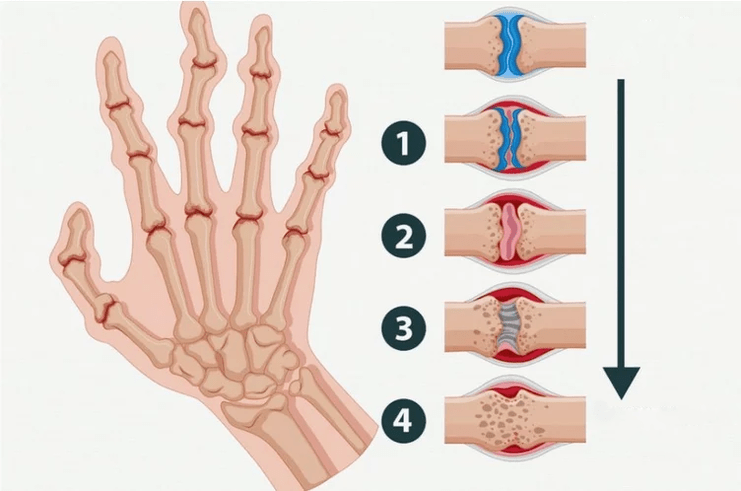
Gout and pseudogout
Metabolic disorders in which hard crystals accumulate in the joints. In gout, uric acid, a product of purine metabolism, precipitates in the form of crystals. Purines are made in the body and come from food. Gout crystals can appear not only inside the joints, but also under the skin and in the tendons. The body reacts to them with severe inflammation. Pseudogout is similar in symptoms to gout, but is caused by the deposition of a different substance - calcium pyrophosphate. Both diseases are treated with drugs, although the drugs are slightly different.
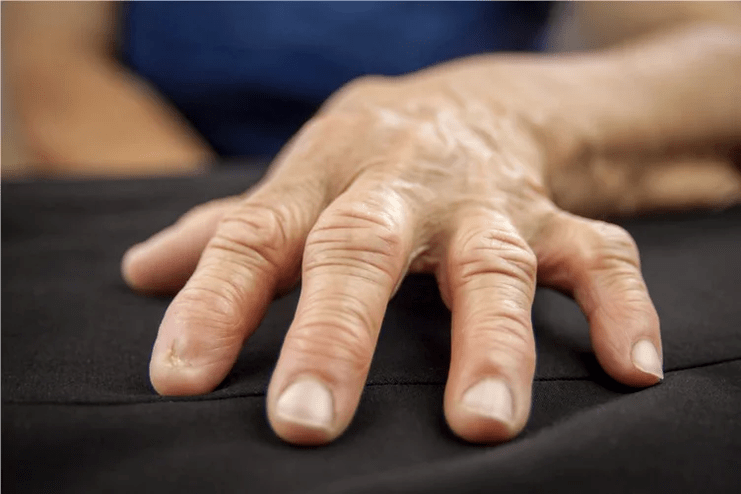
Tumors and cysts
This is a very rare pathology, the vast majority of hand tumors are benign. Cysts can appear in bone tissue and joints. They cause pain and when they are large, they disrupt the range of motion in the joints.
Infectious diseases of the fingers
The most common: criminal and its variety - paronychia. This is an infection of the periungual tissues. Other infections include:
- cellulitis - inflammation of the subcutaneous tissue,
- lymphangitis - inflammation of the lymph vessel,
- abscess - collections of pus,
- osteomyelitis - bone inflammation.
Patients with hand infections usually report previous minor trauma. When a person's immune system is weakened, the risk of these diseases increases.
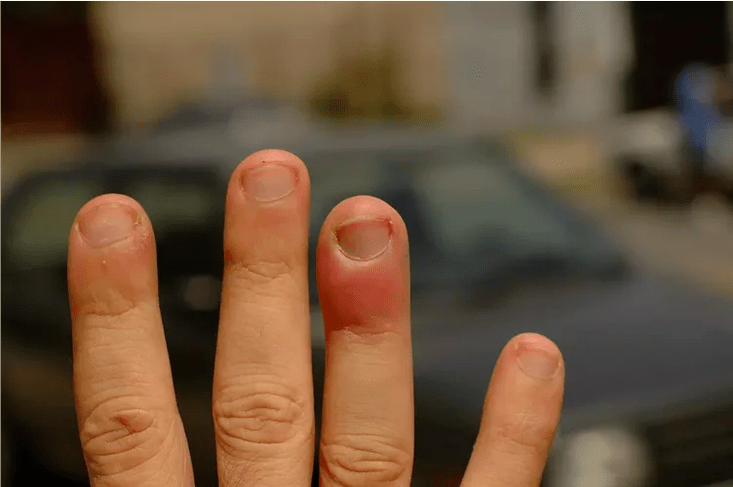
Carpal tunnel syndrome
It is caused by compression of the median nerve in the carpal tunnel formed by the bones, ligaments and tendons of the wrist. Women suffer from this syndrome more than men. Conditions that increase the likelihood of developing the disease: thyroid disease, pregnancy, obesity, diabetes. Constant work with holding the wrist in an extended position for a long time is often a precipitating factor. This is especially true for people in occupations that involve the assembly of small parts or work on computers, such as tailors or surgeons. Symptoms appear in the fingers supplied by the median nerve: the thumb, index, middle and half of the ring finger are close to them. Usually it's not just pain, but numbness, tingling, and pins and needles, and sometimes weakness in the hand.
Dupuytren's contracture or palmar fibromatosis
With this disease, it is impossible to fully straighten the fingers, they are in a forced half-bent position, as a result of which the hand function is impaired. First, dense cords of connective tissue are formed in the palmar tendons, and then they are shortened. More often, the disease appears in men over 50 years of age and has a clear hereditary tendency. As with many other hand pathologies, the risk increases due to diabetes, smoking and occupational hazards.
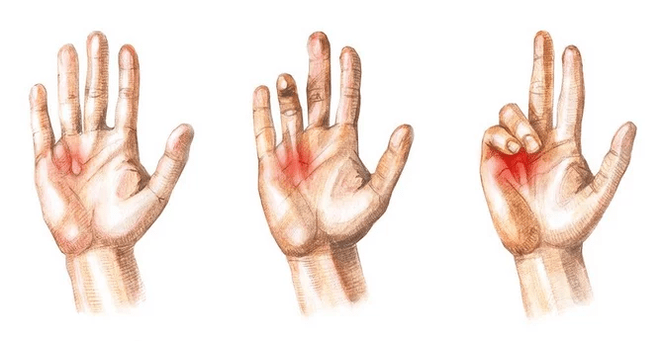
The list of possible diagnoses for pain in the joints of the hands also includes a number of rarer cases: vibration disease, vasculitis, etc. Considering this variety, it is better not to delay contacting a specialist.
Symptoms
Symptoms depend on the disease and its causes. The main symptom of problems with the joints of the hand and its other structures is pain, but it is important to evaluate all its features:
- The onset of pain may be sudden or gradual.Diseases caused by degenerative changes and excessive fatigue of the ligamentous apparatus are characterized by a gradual onset, since the development of these processes takes time. Autoimmune diseases can manifest gradually or acutely. Exacerbation of gout and pseudogout occurs suddenly, reaching the peak of symptoms within a few hours. Trauma is also associated with sharp, sharp pain.
- Time and factors for the appearance or intensification of pain during the day.With carpal tunnel syndrome, the hand may ache at night; pain in osteoarthritis becomes stronger after putting stress on the joints; with rheumatoid arthritis, pain is more pronounced in the first 30 minutes after waking up or prolonged inactivity.
In addition to pain, patients may experience other associated symptoms, including:
- Features of flexion and extension of joints: with "snap finger" the joint is locked in flexion but can be carefully moved into extended position, while "hammer finger" and contracture cannot be fully corrected. With rheumatoid arthritis, you can see the thickening of the fingers in the joints and their deformation. If there is a pathology of the ligaments, nodules can be felt in them.
- Stiffness in the joints and limitation of movements.
- With gout and autoimmune arthritis, the patient will feel redness and swelling, the joint will be warm to the touch - these are symptoms of inflammation.
- If the nerves are damaged, numbness, goosebumps, tingling, and reduced sensitivity to heat, cold, and touch may occur.
- With vasculitis - inflammation of the blood vessels - the fingers are often white or blue.
- Weakness in the hand can be observed with many diseases: this indicates damage to the nerves, and it also occurs with injuries.
- General symptoms such as weakness, fever and other organ problems for which you do not know the cause indicate the systemic nature of the disease. In these cases, it is better to consult a doctor immediately.
Diagnostics
Diagnosis begins with a consultation with a specialist who asks in detail about complaints, concomitant and hereditary diseases. After that, the doctor should examine the patient and palpate the hand. In some cases, these manipulations are enough to make a diagnosis. However, further research is needed to confirm and clarify it. Can be:
- X-rays of hands in different projections- the most widely used and accessible method for assessing the condition of bones and joints. It will be required if there is a suspected fracture, foreign body, developmental abnormalities, tumor or cyst, as well as rheumatoid arthritis and osteoarthritis. On X-ray, osteoarthritis is manifested by the reduction of the joint space, as well as the presence of bone growths - osteophytes.
- CT scan(CT). The compound is used to better visualize fractures and assess the condition of joints.
- Ultrasound of soft tissues and joints of the hand. It allows you to visualize ligaments, tendons, nerve trunks and the condition of joints.
- MRI. The method provides clear layer-by-layer images of all hand structures. The main indications for use are damage to ligaments and tendons.
- Electroneuromyography. This method is necessary to evaluate the conduction of nerve impulses. It is used when carpal tunnel syndrome is suspected.
- Blood tests.Most often it is:
- metabolic indicators - for example, glycated hemoglobin and blood sugar in diabetes, because metabolic diseases affect the condition of nerves, small vessels and ligaments.
- tests for the diagnosis of autoimmune diseases: erythrocyte sedimentation rate, C-reactive protein, rheumatoid factor, antibodies against cyclic citrullinated peptides.
Which doctor should I see?
Diseases of hand structures, due to their great diversity, often require consultation with several specialized specialists. Initially, if there is no actual injury, you should consult a therapist, if an injury occurs, you should consult a traumatologist.
Autoimmune diseases are treated by rheumatologists. Diagnosis and treatment of hand injuries and tumors are carried out by orthopedic traumatologists and surgeons. For metabolic disorders, consultation with an endocrinologist is necessary. If weakness and numbness in the hand are noted, you should consult a neurologist.
How to relieve pain in the joints of the fingers
Treatment can be surgical or conservative.
- Surgical treatmentit is necessary for purulent processes on the hand, as well as for complex injuries. Open wounds also require surgical treatment. Any wound is a source of infection, and such patients are prescribed antibiotics and cleansing. Closed fractures can be treated conservatively. They begin with rigid fixation of the fracture site: 7-10 days for non-displaced fractures and 3 weeks for displaced fractures. After that, the patient wears a special orthosis on the hand until the bone is completely restored - usually 4-10 weeks, sometimes longer.
Conservative treatmentspecial for autoimmune diseases affecting the joints of the hand - it is based on drugs that suppress the immune response and is prescribed by a rheumatologist. Systemic drug therapy is used as part of complex therapy for musculoskeletal problems. For pain in the joints of the hands, non-steroidal anti-inflammatory drugs may be prescribed to relieve pain and inflammation. Local methods of influence have a good effect:
- Injectionscorticosteroids to hand joints, tendons. They effectively eliminate inflammation, but have side effects, so they should be used according to strict instructions.
- Soft fixation of the handusing an orthosis or elastic bandage. The fixation position depends on the diagnosis.
- Exercisesin the muscles of the hand, which a specialist will help to choose depending on the pathology.
- Acupuncture.The method involves inserting sterile needles into biologically active points that relieve pain and improve joint mobility.
- Shock wave therapy.In recent years, it has gained popularity in the treatment of ligament problems. It is effective and safe for the treatment of deforming osteoarthritis, reduces the likelihood of relapse, improves the mobility of the joints and the functionality of the hand as a whole.
- Kinesio taping.This involves attaching special tapes to the hand, which helps to stabilize the joint in a comfortable position. This way it heals faster.
- Laser therapy.It reduces pain and helps repair cartilage, which is extremely important for osteoarthritis.
- Magnetotherapy. It is aimed at reducing pain, inflammation and swelling.
Results
Most patients with hand injuries and degenerative processes, snapping fingers and carpal tunnel syndrome are able to restore joint function and return to a normal lifestyle. The leading role in the prognosis of the disease is played by early consultation with a doctor, correct wearing of bandages, orthosis if indicated, and compliance with prescribed recommendations. If the joints of the hand are not treated for a long time, deformations that cannot be completely eliminated are possible. As soon as you have complaints about the condition of your hand, contact a specialist and he will choose the therapy you need.
Prevention
- Refer to common risk factors.The risk of manual musculoskeletal problems increases with metabolic disorders, smoking and hormonal disorders. Keeping your blood sugar normal is important, especially if you have already been diagnosed with diabetes. A special diet is recommended for gout patients, and some are prescribed anti-gout medications. It will be useful to periodically check the condition of the thyroid gland. A decrease in its function negatively affects the immune system and the whole body.
- If the risk of joint diseases increases, pay attention to your hand.For example, if your work involves overworking your hands, try to ensure the most comfortable position, do not keep your hands constantly bent, give them a rest and warm up a little. Exercise in special gloves, monitor the condition of your skin and nails so that the infection does not penetrate the tissues of your hands. Regularly undergo preventive examinations by doctors.
Follow the listed recommendations and it will help reduce the risk of problems with your hands.


















